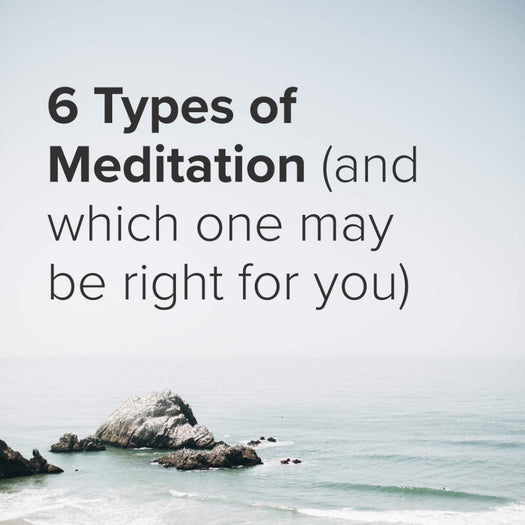6 Types of Meditation (and which one may be right for you)

Interested in starting a mindfulness practice? To help get you started, we’ve put together a list of 6 common types of meditation practices with some associated benefits for you to see which type (or types) may be a good fit for your needs. Take your time, a mindfulness practice is deeply personal – and often one-size does not fit all!
It’s common for people who are new to mindfulness practices to view meditation as a single, uniform practice: sit in silence, focus on breathing, and close your mind off to distractions.
In reality, meditation is far more diverse and should be considered an umbrella term, just as ‘sports’ is an umbrella term that encompasses many types of physical activity, each with their own individual benefits. For example, golf improves coordination and spatial awareness, whereas swimming improves overall aerobic fitness.
Likewise, MRI scans have shown that different types of meditation have different impacts on the brain. [1]
Different Types of Meditation
Just as all sports are not suited to everyone, people tend to gravitate to one form of meditation the most. The key to figuring out which meditation suits you best is based on the benefits you’re seeking, how it fits your lifestyle, and personal preference through trial and error.

1. Mindfulness Meditation
There is often a lot of confusion around the terms “mindfulness” and “meditation” as they are often used as synonyms. Though there are many thoughts on the matter, an easy way to differentiate between the terms is by understanding that mindfulness is a form of meditation. According to Lodro Rinzler, a meditation author and teacher, as well as founder of MNDFL, the practice of meditation predates the idea of mindfulness. He goes on to note that mindfulness is often aligned with the “time of the Buddha,” in which the Buddha discovered that focusing entirely on his breath would allow him to see reality and reach meditation more quickly.
Mindfulness is the practice of being present in the moment; it encourages awareness of existing surroundings and awareness of thoughts without judgment. This is a theme that is common to most types of meditation, such as the ones outlined in this article.
Research has found that mindfulness can: [2]
- Improve memory
- Improve focus
- Improve relationship satisfaction
- Reduce stress
- Reduce anxious thoughts
- Strengthen emotional control and resilience
Mindfulness meditation encourages you to observe wandering thoughts as they drift through the mind. The goal is to not get attached or preoccupied to the thoughts that come to your mind, but to allow them to float by, making a mental note… without judgement.
Through mindfulness meditation, you can see how your thoughts and feelings tend to move in particular patterns and become more aware of how they affect you. In many circumstances, people practice a combination of focused attention meditation and mindfulness meditation – using a single object of focus to help amplify the mindful watching.
2. Focused Attention Meditation
This is the easiest form of meditation for beginners, especially when compared to more traditional forms of meditation. It involves concentrating on a specific object, sound or stimulus as a way of staying in the present moment, as opposed to trying to clear your mind without a single point of focus.
Your object of focus could be the smell of incense, listening to soothing music, staring at a candle flame, or simply focusing your own breath; the goal is not to think about the stimulus, but rather allow yourself to fully experience the sensation it provides. As a form of mindfulness meditation, the main benefits include reduced anxiety, improved concentration and greater emotional flexibility. [2]
Breath awareness is the most popular stimulus, in which you only focus on breathing and ignore other thoughts that enter the mind. The greatest benefit of this method is that it requires no prior training; all that is needed is a quiet spot at home, and a few minutes to focus on your own breathing.
To facilitate this process, you can use a tool like Muse the brain sensing headband, which provides real-time feedback on your mental activity through the guiding sounds of weather to help you keep your focus on your breath.

3. Progressive Muscle Relaxation (Body Scan)
This is a mindful meditation technique – that can be guided or unguided – that encourages people to scan their bodies for areas of tension, notice it, and then release it.
The process begins at one end of the body – for example, the feet – where you can either choose to tense and then relax those muscles, or simply notice the tension in those muscles and then release it. Progressive muscle relaxation encourages deep relaxation and calmness, is often used by people to help them sleep, and may even be useful for chronic pain. [3]
You can find a variety of free resources that offer guided body scan exercises like this Youtube video:
4. Moving Meditation
Although meditation is typically associated with stillness, movement can also help promote a shift of consciousness. Moving meditation involves entering a meditative state while doing simple movements, such as the practice of yoga, or spiritually inspired martial arts such as tai chi or qigong.
However, moving meditation is not relegated to these few practices. Moving meditation can also take the form of walking, dancing or Sufi whirling – whichever movement or rhythm helps clear the mind and enter a meditative state.
The benefits of moving meditation are also well documented in research, and vary based on the type of moving meditation being practiced. For example, a study conducted on healthy seniors in Shanghai revealed that tai chi can delay the onset of dementia, increase brain size and improve memory. [4]
5. Loving-Kindness Meditation (Metta Meditation)
The goal of this meditation is to cultivate an attitude of loving-kindness towards everything – including sources of stress such as work, bad relationships and negative memories.
This is done by sending messages of loving kindness out to the world, and to specific people and situations. This is repeated until you feel you have achieved the attitude of loving-kindness, and are no longer holding onto negative feelings.
This type of meditation is particularly helpful for people who may be dealing with difficult interpersonal conflicts or stressful situations, and are dealing with feelings of anger, resentment or frustration.
Research has shown loving-kindness meditation can increase positive emotions [6], and may be a useful tool to help improve overall wellbeing.
6. Mantra Meditation
This form of meditation centres around a mantra, which is a word or phrase that is recited or listened to during meditation, such as ‘Om’. The mantra can be both spiritual or secular in nature based on the individual.
To understand why a mantra is used, it’s useful to understand the definition of the word mantra. Mantra is a Sanskrit word that is derived from two roots: man (meaning, ‘mind’, or ‘to think’) and trai (meaning ‘to protect’ or ‘free from’, or ‘tool’). Therefore, a mantra is a tool that is used to help free and protect the mind.
Mantras are considered a powerful tool due to their unique sound quality or vibration, their ability to evoke moods, thoughts and emotions, and as a useful way to override mental speech, which is the predominant form of thinking for most people.
Mantra meditation involves going through the following chronological process:
- Verbal recitation
- Whispering recitation
- Mental recitation
- Spontaneous listening (the mantra continues to recite itself in your mind)
Mantras can be combined with visualization, and variables can be altered such as speed or volume of recitation as well.

What Meditation Style Is Right For You?
If you are just getting started, the focused attention model is an ideal starting point, as it is simple, free to do, and has well-researched benefits such as improved focus and memory, stress reduction, and better emotional control.
Progressive muscle relaxation can be considered for sleep problems and chronic pain, and loving-kindness meditation can be considered for anyone suffering from intense feelings of anger, resentment, or frustration. Mantra meditation is also an excellent option for deepening your practice, but one that may require guidance from a practitioner to get started.
At the end of the day, the best way to figure out which type of practice is best for your individual needs is through trial and error.
SOURCES
[1] Valk, S., Bernhardt, B., Trautwein, F., Böckler, A., Kanske, P., Guizard, N., Collins, D. and Singer, T. (2017). Structural plasticity of the social brain: Differential change after socio-affective and cognitive mental training. Science Advances, 3(10), p.e1700489.
[2] Hayes, J. and Davis, D. (2018). What are the benefits of mindfulness?. [online] http://www.apa.org. Available at: http://www.apa.org/monitor/2012/07-08/ce-corner.aspx [Accessed 4 Jul. 2018].
[3] Coppieters, I., Cagnie, B., Nijs, J., Van Oosterwijck, J., Danneels, L., De Pauw, R., & Meeus, M. (2016). Effects of stress and relaxation on central pain modulation in chronic whiplash and fibromyalgia patients compared to healthy controls. PAIN PHYSICIAN, 19(3), 119–130.
[4] Mortimer, J., Ding, D., Borenstein, A., DeCarli, C., Guo, Q., Wu, Y., Zhao, Q. and Chu, S. (2012). Changes in Brain Volume and Cognition in a Randomized Trial of Exercise and Social Interaction in a Community-Based Sample of Non-Demented Chinese Elders. Journal of Alzheimer’s Disease, 30(4), pp.757-766.
[5] Domonell, K. (2018). 5 Surprising Health Benefits Of Yoga. [online] HuffPost. Available at: https://www.huffingtonpost.com/2014/02/12/yoga-health-benefits_n_4768746.html [Accessed 4 Jul. 2018].
[6] Zeng, X., Chiu, C., Wang, R., Oei, T. and Leung, F. (2015). The effect of loving-kindness meditation on positive emotions: a meta-analytic review. Frontiers in Psychology, 6.

